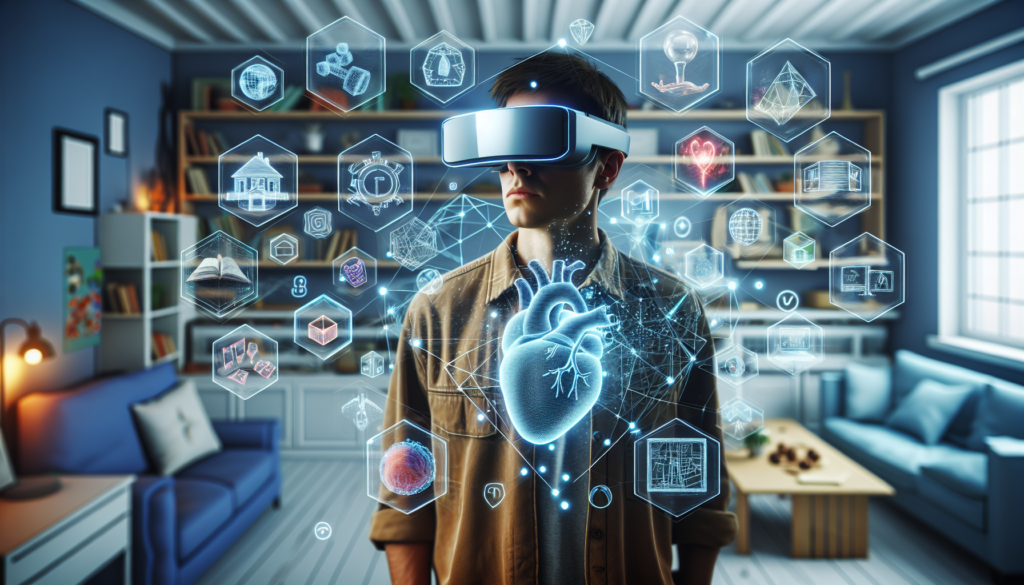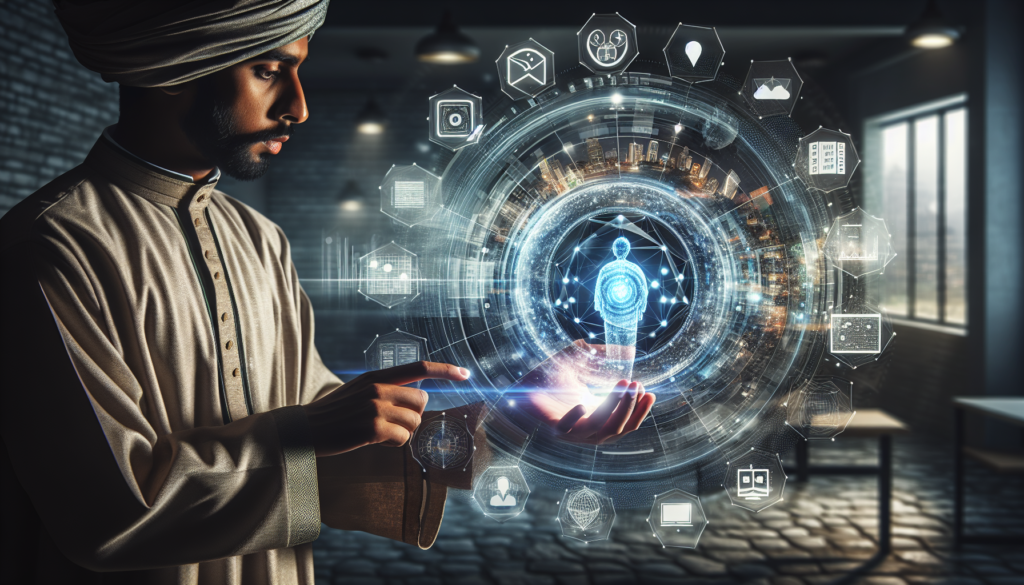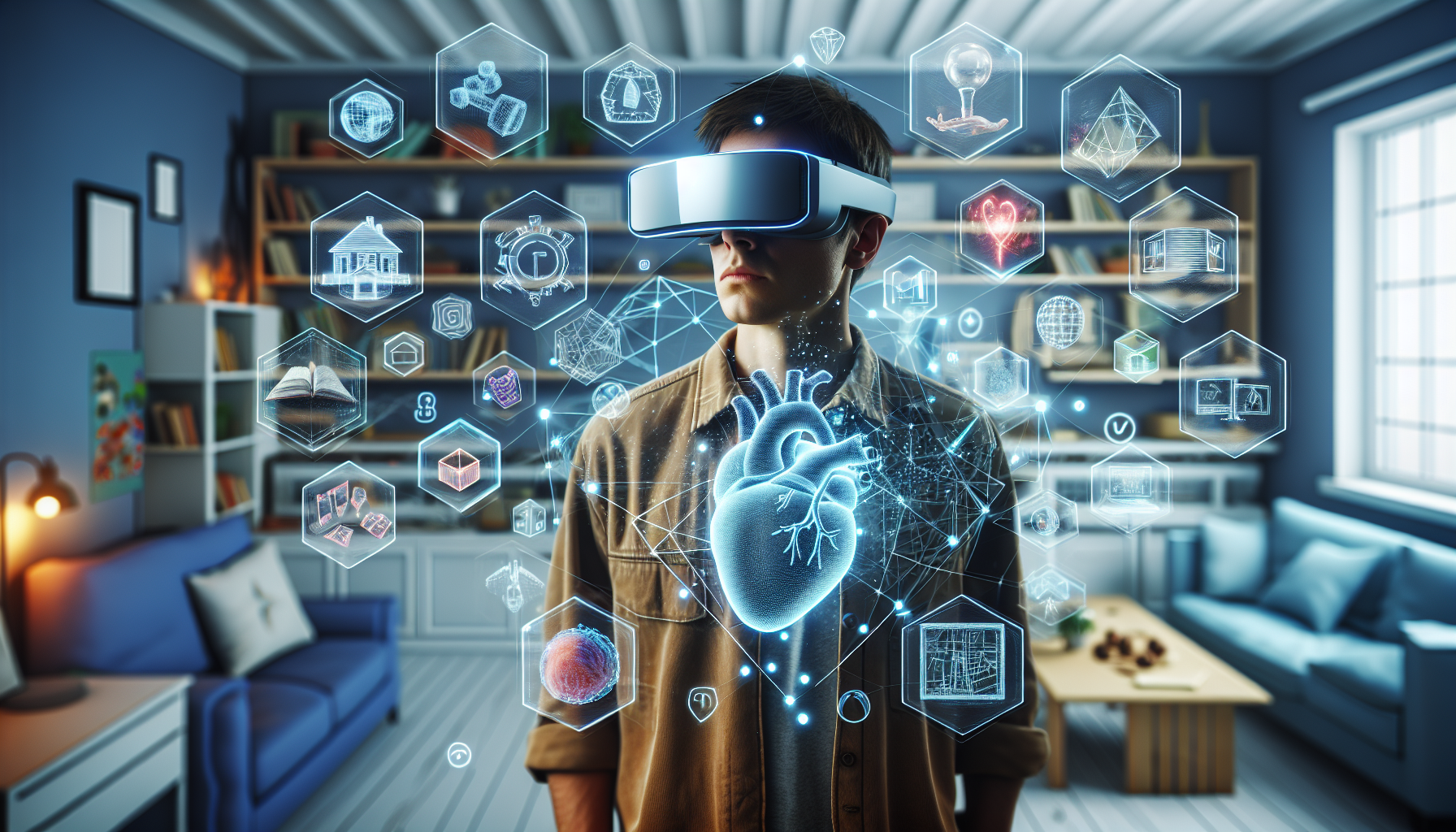Imagine stepping into a world where digital information is seamlessly integrated into your real-life surroundings. Augmented Reality (AR) is the key that unlocks this immersive experience, bringing together the virtual and physical worlds. From trying on virtual clothes to navigating through interactive maps, AR offers limitless possibilities. In this article, we will explore one fascinating example of AR, taking you on a journey that will leave you marveling at the wonders of this transformative technology.

What is AR?
Definition of Augmented Reality
Augmented Reality (AR) refers to a technology that enhances the real-world environment by overlaying digital information, such as images, videos, or 3D models, onto the user’s view using a device like a smartphone, tablet, or AR glasses. Unlike Virtual Reality (VR), which immerses the user in a completely digital environment, AR combines the virtual and physical worlds to create an enhanced user experience.
AR allows users to interact with the digital content in real-time and in the context of their physical surroundings. The digital information is seamlessly integrated into the user’s perception, blurring the line between what is real and what is computer-generated.
Difference between AR and Virtual Reality
While both AR and Virtual Reality (VR) technologies aim to enhance user experiences, there are significant differences between the two. In VR, users are completely immersed in a virtual environment, shutting out the real world. They typically wear a headset that covers their eyes and ears, allowing them to interact with the digital surroundings.
On the other hand, AR overlays digital information onto the real world, allowing users to interact with both the physical and virtual components. Users can still see and hear the real world while engaging with digital content. AR enhances the physical environment, whereas VR creates an entirely separate digital world.
Importance of AR in Various Fields
Augmented Reality has gained considerable importance across various fields due to its ability to enhance and transform human experiences.
In the field of gaming, AR has revolutionized the way people play by blending virtual objects with the real world, providing an immersive and interactive gaming experience. AR has also found applications in navigation, where it helps users navigate through unfamiliar surroundings or provides real-time information about their surroundings.
The retail industry has embraced AR to offer virtual try-on experiences, allowing customers to visualize how products will look on them before making a purchase. AR is also playing a vital role in education, making learning more interactive and engaging with augmented textbooks, anatomy apps, and language learning tools.
In healthcare, AR is being utilized for surgical training simulations and assisting surgeons during complex procedures, leading to improved precision and patient outcomes. With its ability to blend the virtual and physical worlds seamlessly, AR has immense potential in fields such as architecture, automotive, and sports.
Examples of AR in Everyday Life
AR in Gaming
AR has revolutionized the gaming industry, taking gaming experiences beyond the confines of screens and consoles. One of the most popular examples of AR in gaming is Pokémon Go, which took the world by storm in 2016. The game allows players to catch virtual Pokémon creatures in the real world using their smartphones. This innovative game combined GPS technology with AR to create an interactive and immersive gaming experience.
Another notable AR game is Minecraft Earth, a mobile game that brings the block-building creativity of Minecraft into the real world. Players can build structures, collect resources, and interact with virtual elements placed in their physical surroundings through their smartphones.
Harry Potter: Wizards Unite is yet another AR game that transports players into the world of Harry Potter. Players can cast spells, discover magical creatures, and join forces with other wizards in their own neighborhoods, thanks to the integration of AR technology.
AR in Navigation
AR has transformed the way we navigate and explore the world around us. One of the most well-known examples of AR in navigation is Google Maps AR. By utilizing the smartphone’s camera and GPS system, Google Maps AR overlays direction arrows and street names onto the live view of the camera, guiding users to their destinations through real-time augmented reality instructions.
AR Wayfinding in airports is another practical application of AR in navigation. AR technology can provide passengers with interactive maps, guiding them through airports, displaying real-time flight information, and even highlighting points of interest. This helps travelers navigate complex terminals more easily and enhances their overall travel experience.
AR in Retail
The retail industry has embraced AR to provide customers with unique and immersive shopping experiences. Virtual Try-On Apps have become increasingly popular, allowing users to virtually try on clothes, accessories, and even makeup. By using AR technology, customers can see how items look on them in real-time without physically trying them on, which saves time and enhances the online shopping experience.
Interactive Shopping Experiences are another notable application of AR in the retail sector. Brands and retailers have started integrating AR into their physical stores, enabling customers to engage with virtual elements while shopping. For example, customers can use their smartphones to scan product QR codes and access detailed information, reviews, or even view 3D models of the products to make more informed purchase decisions.
AR in Education
AR has introduced innovative ways to deliver educational content and improve learning experiences. Anatomy AR Apps provide students with interactive and immersive ways to explore the human body. Through AR, students can visualize and manipulate 3D models of organs, bones, and systems, enabling a deeper understanding of anatomical structures and their functions.
Interactive Language Learning using AR has also gained attention. Language learning apps can utilize AR technology to display virtual translations and provide real-time pronunciation feedback. By overlaying virtual objects and language prompts in real-world scenarios, AR enhances language comprehension and fosters more engaging and practical language learning experiences.
AR in Healthcare
The healthcare industry has benefited significantly from the integration of AR technology. Surgical Training Simulations using AR allow medical professionals to practice complex procedures in a controlled and realistic virtual environment. This helps improve surgical skills, reduce errors, and enhance patient safety. AR can overlay critical information, such as anatomical structures or vital signs, during surgeries, allowing surgeons to access real-time data without diverting their attention from the operation.
AR-assisted Surgeries are another area where AR has proven invaluable. By using AR glasses or headsets, surgeons can visualize patient-specific anatomical information, preoperative plans, and real-time imaging during surgeries. This assists in guiding surgical interventions with enhanced accuracy and precision, resulting in improved surgical outcomes.
Future Possibilities of AR
AR technology continues to advance rapidly, opening up exciting possibilities in various fields. Here are a few areas where AR holds immense potential for the future:
AR in Architecture and Design
Architects and designers can take advantage of AR to visualize their designs in real-world settings. By overlaying virtual architectural models onto physical spaces, professionals can evaluate designs, make real-time modifications, and showcase their concepts to clients more effectively. AR also enables clients to experience immersive virtual walkthroughs of construction projects before they are built, enhancing communication and collaboration in the industry.
AR in Automotive Industry
AR is already making significant strides in the automotive industry. AR windshield displays can provide drivers with crucial information, such as navigation directions, speed, and warnings, directly in their line of sight. This enhances safety by minimizing the need for drivers to take their eyes off the road. AR can also assist mechanics by overlaying repair instructions and diagnostic information onto vehicles, enabling them to carry out repairs more efficiently.
AR in Sports
AR has the potential to transform the way we experience sports. Imagine watching a live game and seeing digital overlays of player stats, real-time replays, and interactive diagrams that explain complex tactics. AR can provide fans with a more immersive and interactive viewing experience, enhancing their engagement with the sport. Additionally, AR training simulations can benefit athletes by offering realistic scenarios for practice and performance analysis.
Challenges and Limitations of AR
While AR holds immense promise, there are some challenges it currently faces:
Hardware Limitations
AR experiences heavily rely on the hardware capabilities of the devices used. This includes factors such as processing power, battery life, and the quality of cameras and sensors. Currently, not all devices are equipped with the necessary technology to deliver seamless and high-quality AR experiences. Advancements in hardware technology will be crucial to unlocking the full potential of AR.
Privacy and Security Concerns
As AR relies on collecting and processing real-time data about the user’s surroundings, privacy and security become significant concerns. Users need to be assured that their personal information and location data are handled securely. Developers and companies must prioritize implementing robust security measures and obtaining user consent to alleviate these concerns.
User Experience and Adoption
AR applications need to provide intuitive and user-friendly interfaces to ensure a positive user experience. The ease of use, reliability, and functionality of AR apps play a crucial role in their widespread adoption. Developers must continue to refine and simplify AR experiences to make them more accessible to users of all technical backgrounds.

Conclusion
Augmented Reality has emerged as a powerful technology that blends the real and virtual worlds to enhance user experiences in various fields. From gaming and navigation to retail, education, and healthcare, AR is transforming the way we interact with the world around us.
Through innovative applications like Pokémon Go, Google Maps AR, virtual try-on apps, and interactive learning tools, AR has become an integral part of our everyday lives. It has the potential to revolutionize industries like architecture, automotive, and sports, creating new possibilities and enhancing existing processes.
While challenges exist in terms of hardware limitations, privacy concerns, and user adoption, the continuous advancements in technology and the increasing demand for immersive experiences pave the way for a promising future for AR. With further development, AR will continue to enrich our lives, providing us with novel and exciting ways to interact with our environment.
